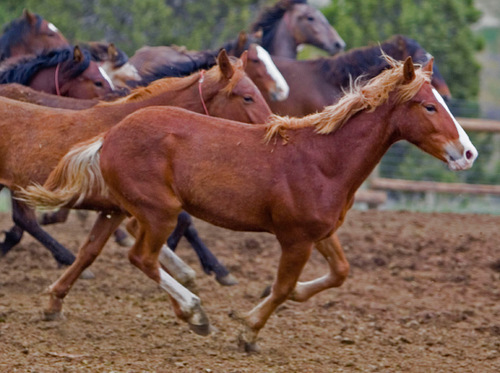This is an archived article that was published on sltrib.com in 2010, and information in the article may be outdated. It is provided only for personal research purposes and may not be reprinted.
The Bureau of Land Management will begin rounding up hundreds of wild horses from the mountainous deserts of western Utah on Tuesday, a move the federal agency says is necessary for the health of the land and the wildlife.
The BLM wants to take 480 horses from herds in the Conger and Confusion mountain ranges, about 75 miles west of Delta. That would leave just 27 percent of the two herds in the wild.
The roundups, Utah's first this season, come as criticism mounts in what is turning out to be the biggest year in memory for removing wild horses from the range.
The BLM's goal is to capture nearly 31 percent of the nation's 38,365 wild horses and burros this year; if it succeeds, 11,783 will be pumped into the pipeline for private adoption or sent to pasture in the Midwest. No wild horses are slaughtered.
In California, horse advocates unsuccessfully sued to block the capture of about 2,000 animals. In response to growing criticism that the program is unnecessarily decimating wild horse herds, Interior Secretary Ken Salazar in late August called for an independent scientific study to re-evaluate his agency's approach.
"They just keep adding more and more horses to holding facilities and the situation ... is completely unsustainable," Suzanne Roy, director of the American Wild Horse Preservation Campaign, said Friday.
Wild horses and burros roam in 10 Western states, with the largest herds in Nevada and California. Last February, the BLM counted 2,724 mustangs and 164 burros on Utah's public lands.
"It's a management tool," said Lisa Reid, spokeswoman for the BLM's Fillmore office, which will run the "gathers" — the agency's term for roundups — during the next two weeks. "We try to provide an ecological balance between horses and wildlife and recreation."
Wild horses, lacking predators such as grizzlies, wolves or mountain lions, will double in number every four years if left alone.
The number of wild horses in the Confusion and Conger mountain ranges is far higher than the range can handle, the BLM's Mike Gates, field office manager, said in an early August news release.
"Our horses are healthy, and we want them to remain healthy," Gates said. "We must manage the population at appropriate levels to maintain an ecological balance on the range."
The agency last took wild horses from the Confusion herd in 2004, when 154 were gathered, and from the Conger herd in 2006, when 123 were removed.
During this month's roundups, the BLM will capture and release some of the horses, including an estimated 50 studs in the Confusion herd and another 20 in the Conger herd. Also, 10 mares in the Conger herd are to be treated with fertility control and returned to the range.
Adjusting the sex ratios in the herds, the agency says, will slow the population growth.
Roy, like other critics, believes public lands could hold many more horses.
The BLM, she said, is being stingy with wild horses and overly generous with cattle and sheep that graze many millions more acres of federal land.
"It's all about money," she said, "and it's all about the power of the livestock lobby."
Further complicating the issue is the growing stockpile of wild horses.
Those who are too old or otherwise unsuitable for adoption end up in pastures that Reid likens to "rest homes" for horses. Those are all in the Midwest.
The economic downturn has dampened demand for wild-horse adoptions, so even more animals end up in the long-term pastures.
According to the BLM website, it cost taxpayers $29 million in the 2009 budget year to care for the horses in captivity. As of August, according to the agency, there were 25,700 permanently pastured wild horses and 8,800 in short-term corrals, likely bound for adoption.
View the roundup
The public is welcome to view Tuesday's wild horse roundup, according to the Bureau of Land Management. An escorted tour will leave promptly at 6 a.m. from The Border Inn in Baker, Nev., on the Utah-Nevada line. Observers must be prepared for weather extremes, carry food and water, and use four-wheel drive vehicles with high clearance.



